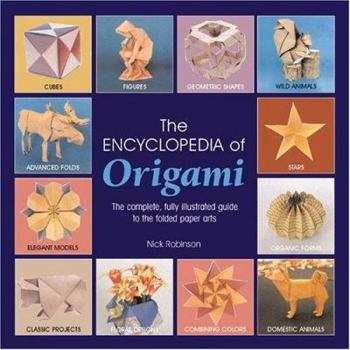The Encyclopedia of Origami: The Complete, Fully Illustrated Guide to the Folded Paper Arts
Select Format
Select Condition 
Book Overview
The infinite possibilities of paper folding inspired origami, a simple, traditional craft that appeals to both children and adults. This comprehensive guide to the materials, tools, techniques,... This description may be from another edition of this product.
Format:Hardcover
Language:English
ISBN:0762418958
ISBN13:9780762418954
Release Date:September 2004
Publisher:Running Press Book Publishers
Length:160 Pages
Weight:1.70 lbs.
Dimensions:0.8" x 9.0" x 9.1"
Customer Reviews
3 ratings
The Encyclopedia Of Origami: The Complete, Fully Illustrated Guide to the Folded Paper Arts
Published by Thriftbooks.com User , 17 years ago
A worth addition to an enthusiast's library. Suits a folder who is looking to start folding and those who are further along the path to enlightenment.
Pretty but not encyclopedic
Published by Thriftbooks.com User , 18 years ago
Okay, first what I didn't like. "Encyclopedia." Nope. Not by a long shot. Even counting the endpapers, the book is only 168 pages in length. Admittedly it's in 10 pt font size, but it's filled with photos--lovely ones--and there's no way you could write an encyclopedic work on origami in so limited a space. There's just too much to say about it, and most of it would probably bore the average person to death. One suspects that they've running out of unused descriptive titles for books on origami, and "encyclopedia" had not been used yet. For something a little closer to an encyclopedia--although even here it's moot--I'd look at Origami Omnibus or Origami for the Connoisseur, both by Kunihiko Kasahara--the latter book with Toshie Takahama. These at least integrate something of the geometrics and mathematics of origami. The next negative. The cover photos are magnificent. It's what encouraged me to purchase the book in the first place. There were so many incredible designs illustrated, and I'm always looking for something new, especially in natural looking animals and in masks. Unfortunately, many of those illustrated on the cover are not described in the book other than in the "gallery" of works by masterfolders. True, only the very experienced folder might be able to do some of these,and they will probably be able to figure them out from the photos, but it might be nice if some of us were given the option and the help to try. In this category I'd place: the lovely little squirrel by La Fosse, the moose by Lang, the magnificent elephant by Brill, the several toed frog by Land, the very lifelike dog by Yoshizawa, the delightful mouse character, incredible seahorse and the masterful masks by Joisel. Especially for the latter artist, there really are no superlatives impressive enough to describe his work. It has to be seen to be believed. These issues aside, and I admit they are small ones from the perspective of the beginner, those things I did like were quite a few. I liked the design for the fish. It's one I hadn't seen yet. The Baggi box and the triangular box, both of single pieces of paper, were also new to me. I'm more accustomed to seeing the modular forms for boxes, like those of Fuse, the patterns for one of whose square boxes is also presented. I liked the ten-point star for its impressiveness despite its utter simplicity. I also liked the 5 pointed star, the open cube, the skeletal cube, and the bear model. The CD case appealed to me because it had such obvious immediate and versatile uses. The square dissection puzzle left me a little cold until I realized it would make a great frame for a photograph. As I say, the book has much to recommend it, but if you're looking for a reference work on origami, you'll be disappointed.
Enjoyable projects, nice results, good book
Published by Thriftbooks.com User , 19 years ago
One of the better origami books, The Encyclopedia of Origami does one of the best jobs of describing and illustrating how to make the folds that I have seen. That is usually the biggest problem with origami books, how do you describe and illustrate an unusual fold? This is a three-dimensional activity illustrated in a two-dimensional medium and is difficult to describe well. Author Nick Robinson does a great job and all the folds on the projects I did were easy to figure out. The book is divided into five sections that work from basic techniques to beginner projects to intermediate projects to challenging projects and ends with a photographic piece on origami from around the world. This last section showcases masterful pieces of origami work and while it does not include instructions for these pieces it does provide a glimpse of what can be done by a professional. Some of the included subjects include geometric shapes, animals, and flowers. With projects for all ages, The Encyclopedia of Origami is a wonderfully fun book anyone can use to successfully fold origami pieces and a highly recommended book.





